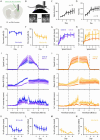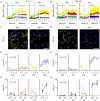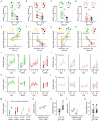This is a preprint.
Refinement of efficient encodings of movement in the dorsolateral striatum throughout learning
- PMID: 38895486
- PMCID: PMC11185645
- DOI: 10.1101/2024.06.06.596654
Refinement of efficient encodings of movement in the dorsolateral striatum throughout learning
Abstract
The striatum is required for normal action selection, movement, and sensorimotor learning. Although action-specific striatal ensembles have been well documented, it is not well understood how these ensembles are formed and how their dynamics may evolve throughout motor learning. Here we used longitudinal 2-photon Ca2+ imaging of dorsal striatal neurons in head-fixed mice as they learned to self-generate locomotion. We observed a significant activation of both direct- and indirect-pathway spiny projection neurons (dSPNs and iSPNs, respectively) during early locomotion bouts and sessions that gradually decreased over time. For dSPNs, onset- and offset-ensembles were gradually refined from active motion-nonspecific cells. iSPN ensembles emerged from neurons initially active during opponent actions before becoming onset- or offset-specific. Our results show that as striatal ensembles are progressively refined, the number of active nonspecific striatal neurons decrease and the overall efficiency of the striatum information encoding for learned actions increases.
Figures




Similar articles
-
Dynamics of striatal action selection and reinforcement learning.bioRxiv [Preprint]. 2024 Jul 25:2024.02.14.580408. doi: 10.1101/2024.02.14.580408. bioRxiv. 2024. PMID: 38464083 Free PMC article. Preprint.
-
Differential Development of Dendritic Spines in Striatal Projection Neurons of Direct and Indirect Pathways in the Caudoputamen and Nucleus Accumbens.eNeuro. 2023 Jun 12;10(6):ENEURO.0366-22.2023. doi: 10.1523/ENEURO.0366-22.2023. Print 2023 Jun. eNeuro. 2023. PMID: 37253589 Free PMC article.
-
Striatal Direct Pathway Targets Npas1+ Pallidal Neurons.J Neurosci. 2021 May 5;41(18):3966-3987. doi: 10.1523/JNEUROSCI.2306-20.2021. Epub 2021 Mar 17. J Neurosci. 2021. PMID: 33731445 Free PMC article.
-
A Population of Indirect Pathway Striatal Projection Neurons Is Selectively Entrained to Parkinsonian Beta Oscillations.J Neurosci. 2017 Oct 11;37(41):9977-9998. doi: 10.1523/JNEUROSCI.0658-17.2017. Epub 2017 Aug 28. J Neurosci. 2017. PMID: 28847810 Free PMC article.
-
Neural circuit mechanism for learning dependent on dopamine transmission: roles of striatal direct and indirect pathways in sensory discrimination.Adv Pharmacol. 2013;68:143-53. doi: 10.1016/B978-0-12-411512-5.00007-5. Adv Pharmacol. 2013. PMID: 24054143 Review.
References
Publication types
Grants and funding
LinkOut - more resources
Full Text Sources
Miscellaneous

